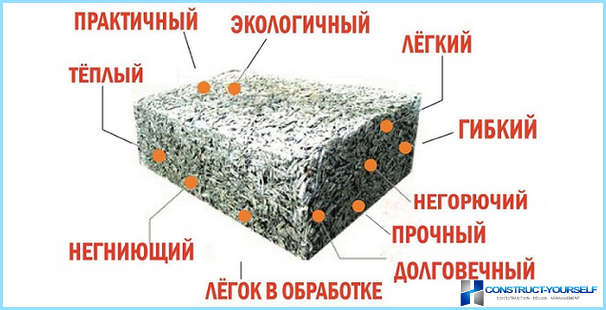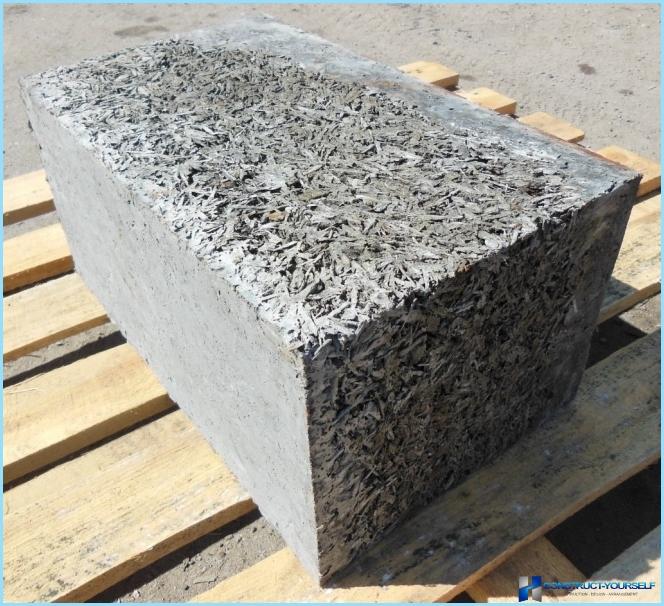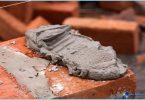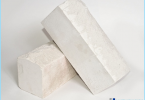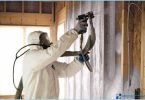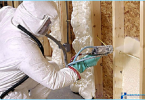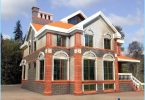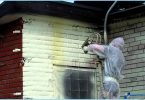The contents
For anybody not a secret that the ideal building material yet, unfortunately, not invented. Whichever you choose, whether brick, wood or concrete products, they all have their pros and cons. So you have to choose from what are. But there is one material that you can say almost close to perfection. This is one of the types of lightweight concrete. Its use has become very popular. What is this stuff? Arbolit – in whose part of the United wood chips and cement. 80-90% of the total volume is wood, so it combines the pros and cons of these two materials. Arbolit is used as a ready mix for the fill in place, and blocks for masonry. Wood concrete blocks you can see in the photo below.
In this article we will tell you about all the advantages and disadvantages, which are concrete blocks. Then you will understand why it is one of the best.
Low thermal conductivity and density ↑
One of the main advantages of concrete blocks and low heat conductivity. This indicator is very important, as it characterizes how well the building will retain and give off heat. This allows you to save on heating and enjoy a comfortable stay in his house.
Wood concrete blocks can be called the most heat-resistant product for construction. So why can I say? This is evidenced by simple numbers. According to the conductivity of heat arbolita is 0.08–0.17 W/MK. And despite the fact that its density is around 400-850 kg/mThree. For comparison, look at photos and analyze how concrete blocks are distinguished from other materials by this measure.
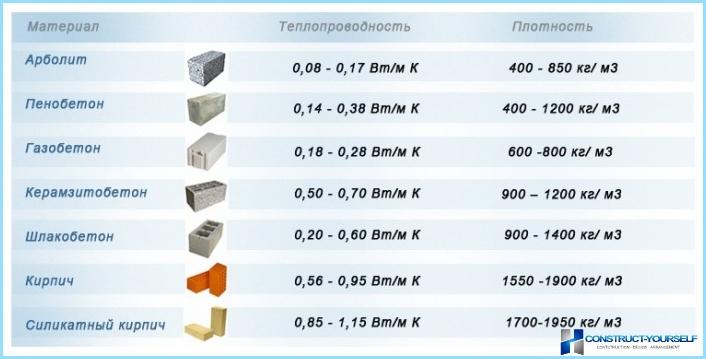
We can confidently say that the arbolit is the most warm material among their «fellow». For example, cement wood lined with a wall thickness of 30 cm for the conduction of heat is equivalent to a wall of brick with a thickness of about 1 m. Impressive? All thanks to the fact that the main raw material is wood, of which the thermal conductivity is 0.15 W/MK. Pleased that the house of arbolita does not require insulation. Enough to handle the warm plaster is 1.5–2 cm layer. This will considerably save your funds.
The conductivity directly influences the density of the material. The lower it is, the higher the conduction of heat. It wood concrete blocks are divided into two types:
- Insulation.
- Structural.
The insulating blocks are characterized by a density of 500 kg/mThree. The thermal conductivity is higher. But, the build of material load-bearing walls are prohibited as they may not withstand the load. This layout is suitable for thermal insulation of external walls of the building. But structural units are suitable for construction of load-bearing walls. Their density ranges from 550-850 kg/mThree, however, the heat conductivity is worse.
Light weight ↑
With its dimensions, the weight of the blocks is quite small. Wall stone size 500?250?300 mm has a specific weight of 24 kg. After all, it’s a lot, some may argue, because the conventional red brick only weighs a 3.45 kg. It is true, but let’s look at the big picture.
As you know, in 1 cube of masonry, there are 26.6 units. But bricks in 1 cube of masonry 512 PCs the Difference is obvious. Now let’s make some calculations: 26,6 (PCs) ? 24 (kg) = 638,4 kg in 1 mThree blocks from arbolita. Now the brick: 512 (PCs) ? 3.45 m (kg) = 1766,4 kg in 1 mThree. Amazingly, wood concrete blocks weigh almost 2.5 times less than the bricks. What gives? First, you is easy to work with them. This size and weight allows no obstacles to carry items and to perform the masonry. Secondly, the light weight allows you to save money on building a house. How? If heavy buildings require an in-depth, solid and sophisticated Foundation that would cost a lot, for houses from arbolita to do.
The simplicity of execution of works ↑
Another important factor is the usability of the material. And then-concrete blocks are also excellent. Working with them is a pleasure. Due to the size, walls are very short, so build a box building a business fast. In addition, the material is perfectly processed. It can cut, chop, nail and enter the screws. Have you tried to hammer a nail into brick or aerated concrete? Most often, the material will crack. But the arbolit withstand all the manipulation, which is carried out.
If necessary, the blocks are adjusted to the desired size. Only need to do the layout and cutting material with a saw, manual or electric. The cut will be smooth and neat. You can see in the photo.
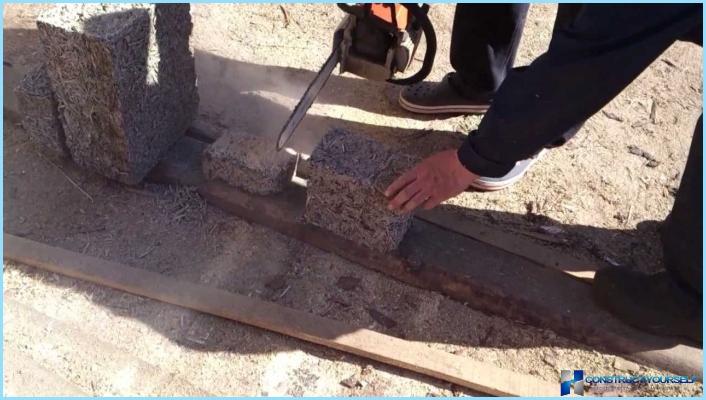
And if we talk about plastering the surface, good adhesive properties enable you to apply plaster without reinforced stacks.
The strength and durability ↑
This indicator articles on top and surprising. Block strength under compression is 0,5–3,35 MPa. Silicate bricks have a strength of 7.5–35 MPa. And with a Flexural strength that is equal to 0.7–1.0 MPa and a modulus of elasticity 250-2300 MPa concrete blocks are simply not kill. For the operation of the premises, this fact is very significant. Durability of foam concrete and aerated 2 times lower.
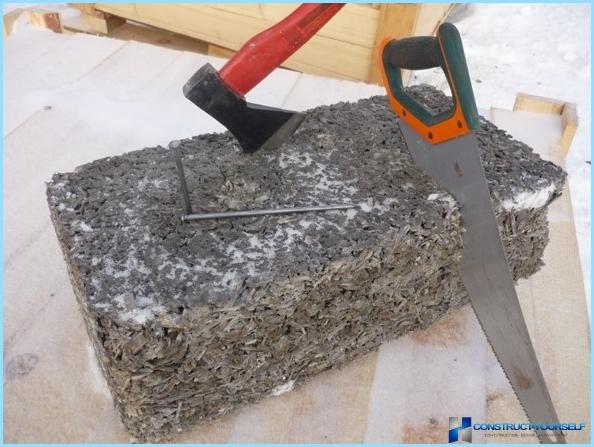
This ensures that the arbolit practically does not shrink, so no cracks on it you will not see. It can withstand heavy loads without losing the original form. Any mechanical damage the unit also not terrible. And thanks to the plasticity of the material at maximum load, it does not break and deform. After load out, he will return to their original shape.
Refractoriness ↑
To burn wood concrete blocks you will be difficult, because they belong to the group of combustibility G1 – combustible material, according to GOST 12.1.044/89. Despite the fact that the composition is wood, it is hard to fire it up and it belongs to the group B1 (GOST 30402). Making a house out of arbolit, you can not worry that in an emergency he will break out like a match. In addition, on the basis of GOST 12.1.1044.89, the parameters smoke it in group D1 – multivariately. Your home will be safe for complete incombustibility of the material.
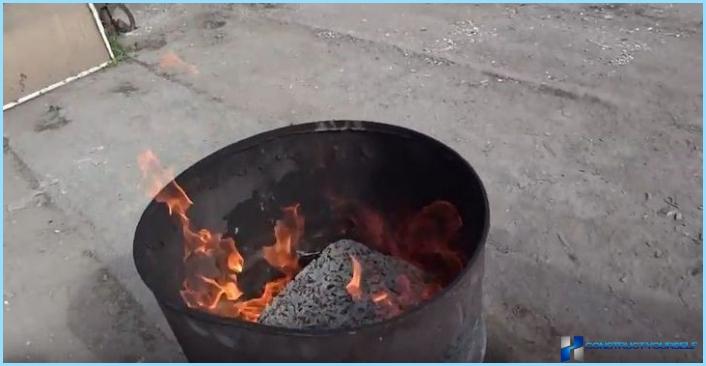
High soundproofing ↑
If you build a room in the area where quite noisy, wood concrete wall in combination with good glass will provide better insulation. This is confirmed by its characteristics. Sound absorbing material is 0,17–0,6 units, with the frequency of the sound 130-2000 Hz. For example, the bricks, the figure is not higher, and 0.04 at 1000 Hz, and the tree generally 0,06–0,1.
This suggests that in addition to soundproofing the room is not necessary, as the walls themselves deal with the absorption of extraneous sound from outside.
Ecological purity ↑
Wood concrete blocks is 100% environmentally friendly and do not harm your health. This is not surprising because they are almost entirely of wood, the natural ingredients gifted to us by nature. Nowadays the requirements for sustainable materials is high enough. And here arbolit also remains high.
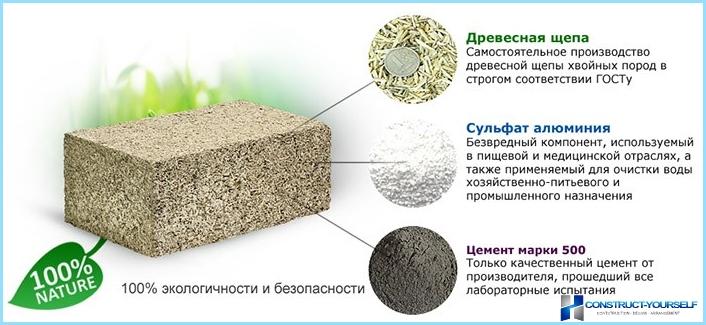
It should be noted that it does not rot and is resistant to mildew and fungus. This prolongs its service life. And yet, arbolit breathable, allowing you to create smooth indoor microclimate.
Frost resistance ↑
If you mention the pros arbolita to miss this factor is simply impossible. Frost-resistance is characterized by the number of cycles of freezing and thawing of the material. At arbolita, the figure is F25–F50 (number of cycles). I suggest you look at the photo below to compare these figures with other materials.
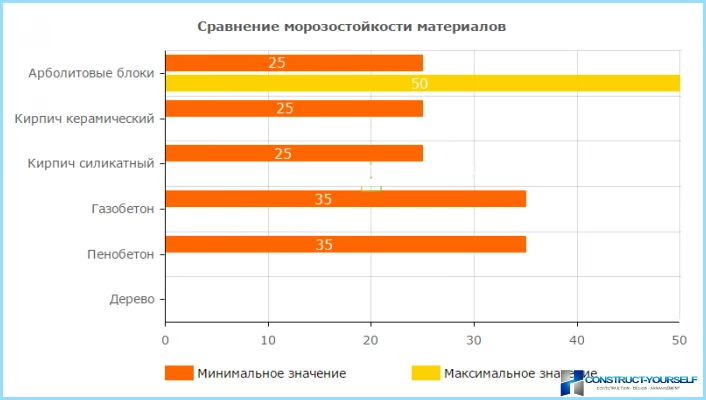
The combination of all the indicators makes the material durable, reliable and profitable. But, something perfect does not exist a priori. Arbolit has its minor disadvantages.
Cons arbolita ↑
Wood concrete blocks disadvantages:
- The market is filled with products «garage» quality. Therefore, to calculate their resistance, density, strength, etc. is simply unrealistic. It turns out that you can buy the cat in the bag.
- Small precision geometry. If you compare with other types of cellular concretes, the arbolit this figure is small. All can lead to a kind of deviation in the clutch.
- The material must be protected from direct exposure to the environment. Everything is solved applying the plaster.
- High cost. Everything related to technology development units. Their costs are 1.5 times higher than the foam/gas. Still, given all its advantages, a strong red, we can’t. For the quality, as you know, you have to pay.
- Limitations in the choice of finishing material. It needs to breathe, like concrete block.
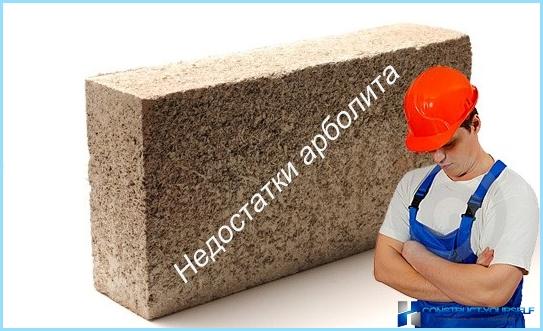
Conclusions ↑
We have considered all the pros and cons of concrete blocks. Compared to advantages, its disadvantages are not so significant. They can not be taken into account. But as they say, you decide. You can analyze all the pros and cons of concrete blocks and draw their own conclusions.
